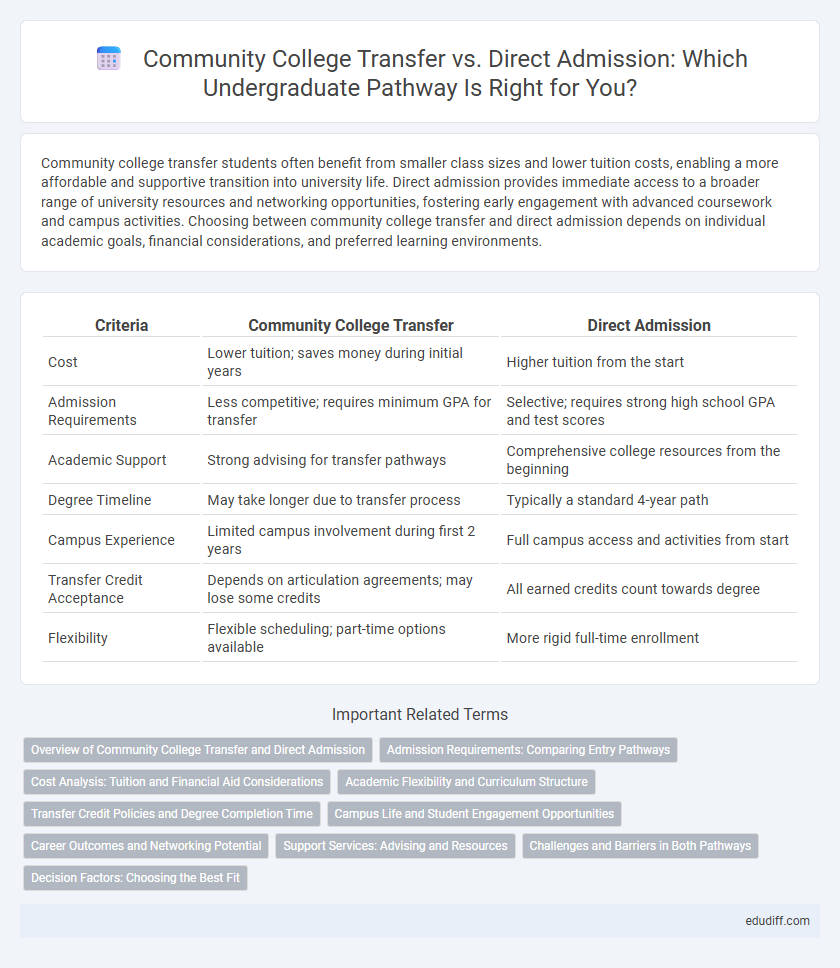Community college transfer students often benefit from smaller class sizes and lower tuition costs, enabling a more affordable and supportive transition into university life. Direct admission provides immediate access to a broader range of university resources and networking opportunities, fostering early engagement with advanced coursework and campus activities. Choosing between community college transfer and direct admission depends on individual academic goals, financial considerations, and preferred learning environments.
Table of Comparison
| Criteria | Community College Transfer | Direct Admission |
|---|---|---|
| Cost | Lower tuition; saves money during initial years | Higher tuition from the start |
| Admission Requirements | Less competitive; requires minimum GPA for transfer | Selective; requires strong high school GPA and test scores |
| Academic Support | Strong advising for transfer pathways | Comprehensive college resources from the beginning |
| Degree Timeline | May take longer due to transfer process | Typically a standard 4-year path |
| Campus Experience | Limited campus involvement during first 2 years | Full campus access and activities from start |
| Transfer Credit Acceptance | Depends on articulation agreements; may lose some credits | All earned credits count towards degree |
| Flexibility | Flexible scheduling; part-time options available | More rigid full-time enrollment |
Overview of Community College Transfer and Direct Admission
Community college transfer allows students to complete foundational coursework at a lower cost before moving to a four-year institution, often improving accessibility and flexibility. Direct admission offers immediate entry into a bachelor's degree program, providing a streamlined path without the need for additional application processes. Both pathways cater to different academic and financial needs, impacting students' access to higher education and degree completion times.
Admission Requirements: Comparing Entry Pathways
Community college transfer students typically need to meet minimum GPA requirements, complete specific prerequisite courses, and submit official transcripts for admission consideration. Direct admission applicants often face more stringent criteria, including standardized test scores, a comprehensive application, and demonstrated extracurricular involvement. Understanding these differing admission requirements helps prospective undergraduates choose the most strategic entry pathway for their academic goals.
Cost Analysis: Tuition and Financial Aid Considerations
Community college transfer often provides a cost-effective pathway to a four-year degree, with significantly lower tuition fees during the initial two years compared to direct admission at universities. Financial aid opportunities may differ, as community colleges tend to offer robust state and local grants, while universities might provide larger merit-based scholarships for first-time freshmen. Evaluating total expenses, including tuition, fees, housing, and aid packages, is crucial in determining the most affordable route to degree completion.
Academic Flexibility and Curriculum Structure
Community college transfer offers significant academic flexibility by allowing students to complete general education requirements at a lower cost before entering a four-year institution, where they can focus on specialized courses. Direct admission to a university typically involves a more structured and rigid curriculum path, with less room for elective coursework or changing majors early on. Community colleges' modular course design supports diverse learning paces, whereas universities often follow fixed semester-based progression for degree completion.
Transfer Credit Policies and Degree Completion Time
Community college transfer policies vary widely, with some institutions accepting up to 90 transferable credits, significantly reducing the time to bachelor's degree completion. Direct admission students typically start with zero college credits, facing a standard four-year graduation timeline, whereas transfer students can often finish in two to three years depending on credit equivalencies. Evaluating articulation agreements and transfer credit limits is crucial for minimizing credit loss and accelerating degree completion for community college transfers.
Campus Life and Student Engagement Opportunities
Community college transfer students often benefit from smaller class sizes and tight-knit campus communities, fostering personalized interactions and easier access to student organizations. Direct admission students typically experience a broader range of campus life activities, including extensive clubs, leadership programs, and intramural sports that enhance student engagement. Both pathways offer unique opportunities for involvement, but direct admission campuses usually provide more diverse resources and extracurricular options.
Career Outcomes and Networking Potential
Community college transfer students often experience significant cost savings and access to tailored support services, which can enhance their career outcomes through practical skill development and local industry connections. Direct admission students typically benefit from earlier integration into university networks, providing broader access to internships, research opportunities, and professional organizations that boost long-term career prospects. Both pathways offer distinct advantages in networking potential, with community college transfers leveraging strong regional ties and direct admits capitalizing on expansive university networks.
Support Services: Advising and Resources
Community college transfer students benefit from tailored advising services that focus on credit evaluation and transfer pathways, ensuring a smooth transition to four-year institutions. Direct admission students typically have immediate access to comprehensive campus resources, including academic tutoring, career counseling, and faculty mentorship programs. Both pathways offer specialized support services designed to enhance student success but differ in the timing and type of guidance provided.
Challenges and Barriers in Both Pathways
Community college transfer students often face challenges such as credit transfer issues, limited access to campus resources, and longer time to degree completion compared to direct admission students. Direct admission students may encounter barriers in adapting to rigorous academic expectations and navigating financial aid processes without prior college experience. Both pathways require careful planning to overcome administrative hurdles and ensure a smooth transition toward graduation.
Decision Factors: Choosing the Best Fit
Community college transfer and direct admission each offer unique advantages depending on academic goals, financial considerations, and campus culture preferences. Evaluating factors such as transfer credit acceptance, cost savings, campus involvement opportunities, and degree program availability helps determine the best fit. Students should carefully compare graduation rates, support services, and class sizes to align their decision with long-term career aspirations.
Community College Transfer vs Direct Admission Infographic

 edudiff.com
edudiff.com